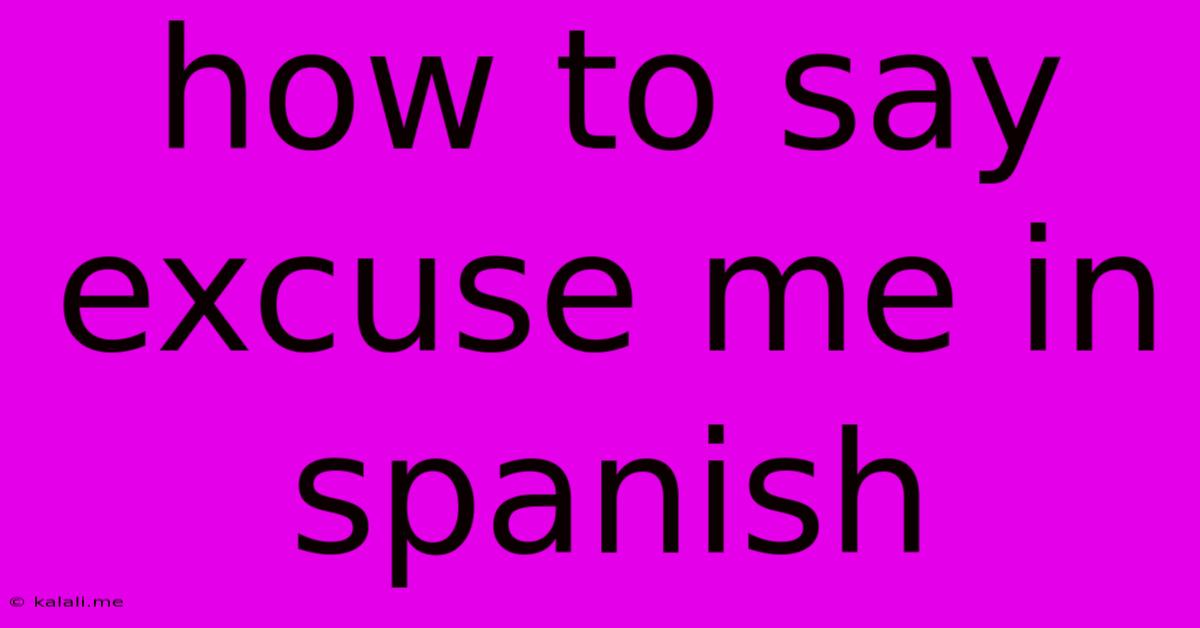How To Say Excuse Me In Spanish
Kalali
May 20, 2025 · 3 min read

Table of Contents
How to Say "Excuse Me" in Spanish: A Comprehensive Guide
Knowing how to say "excuse me" in Spanish is crucial for navigating conversations and everyday situations in Spanish-speaking countries. This seemingly simple phrase has several nuances depending on the context, making it more than just a simple translation. This guide will explore various ways to express "excuse me" in Spanish, along with helpful tips on when to use each one.
Meta Description: Learn how to say "excuse me" in Spanish with this comprehensive guide. We explore various ways to politely excuse yourself, covering formal and informal situations and offering valuable cultural context.
The Most Common Ways to Say "Excuse Me" in Spanish
The most straightforward translation of "excuse me" is "disculpe". This is a formal and versatile option suitable for most situations, from politely interrupting someone to asking for directions. It's a safe bet if you're unsure which phrase to use.
-
Disculpe (Formal): This is the equivalent of a formal "excuse me," suitable for addressing elders, authority figures, or strangers in more formal settings.
-
Perdón (Informal/Formal): While often translated as "sorry," perdón can also function as "excuse me," particularly when you've unintentionally bumped into someone or need to get their attention. It's generally acceptable in most situations, both formal and informal. It's slightly less formal than disculpe.
-
Con permiso (Formal/Informal): This translates to "with permission," implying you are asking for permission to pass or interrupt. This phrase is commonly used when needing to pass through a crowded area or politely interrupt a conversation.
Choosing the Right Phrase: Context Matters
The best way to say "excuse me" in Spanish depends heavily on the context. Here's a breakdown:
-
Getting someone's attention: Disculpe or Perdón are both excellent choices for this. You can simply say Disculpe or Perdón followed by your request.
-
Interrupting someone: Disculpe or Con permiso are better suited for interrupting someone, especially in a formal setting. Starting with one of these phrases shows respect.
-
Bumping into someone: Perdón is the most natural choice if you accidentally bump into someone. It conveys apology and excuse simultaneously.
-
Asking for directions or help: Disculpe is a polite and appropriate way to start a request for assistance.
Beyond the Basics: Adding Politeness
Spanish speakers value politeness, so adding a polite phrase can significantly enhance your interaction. Consider adding:
-
Por favor: (Please) - Adding por favor after disculpe or perdón further emphasizes your politeness. For example: "Disculpe, por favor, ¿dónde está el baño?" (Excuse me, please, where is the bathroom?)
-
¿Me podría ayudar?: (Could you help me?) – This phrase is useful when requesting assistance.
Mastering the Nuances of "Excuse Me" in Spanish
Learning these various ways to say "excuse me" and understanding the appropriate context will not only improve your Spanish but also demonstrate cultural sensitivity. Mastering these nuances will show that you're making an effort to communicate respectfully within the Spanish-speaking culture. Remember to practice using these phrases in real-life situations or through conversational practice. The more you use them, the more naturally they will flow in your conversations.
Latest Posts
Latest Posts
-
How To Evolve Eevee Into Umbreon Pokemon Go
May 20, 2025
-
Adam And Eve Had 33 Sons And 23 Daughters
May 20, 2025
-
What Are Utility Knives Used For
May 20, 2025
-
How Long Is Chicken Good For After Defrosting
May 20, 2025
-
Replacing A Dimmer Switch With Regular Switch
May 20, 2025
Related Post
Thank you for visiting our website which covers about How To Say Excuse Me In Spanish . We hope the information provided has been useful to you. Feel free to contact us if you have any questions or need further assistance. See you next time and don't miss to bookmark.